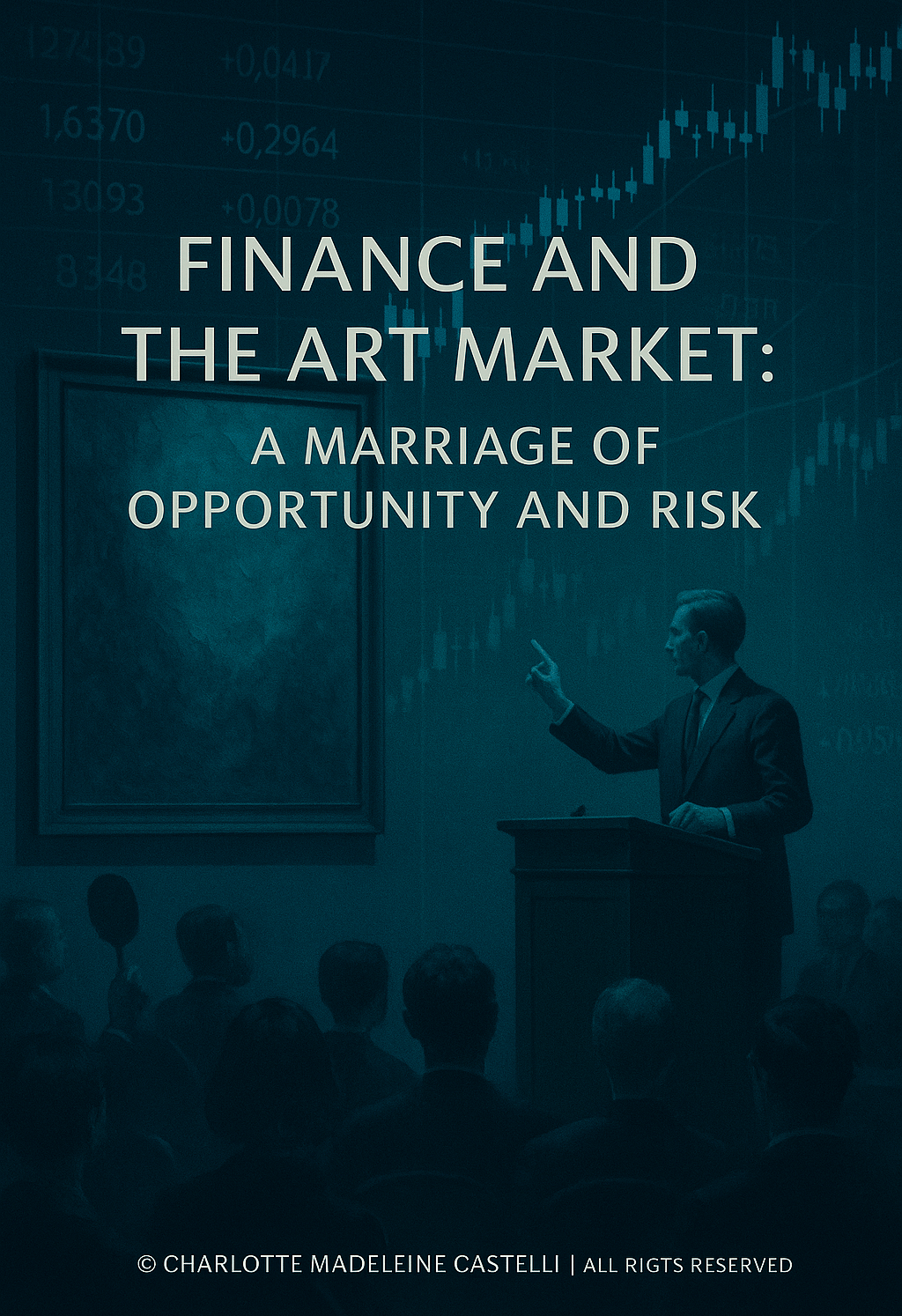Finance and the Art Market: A Marriage of Opportunity and Risk in the Past Week
Over the past seven days, the worlds of finance and art have become increasingly intertwined, capturing the attention of investors, collectors, and cultural enthusiasts alike. Behind the dazzling lights of multimillion-dollar auctions and turbulent stock markets lies a story of profound transformations and emerging dynamics that are reshaping the global landscape. Let us explore what has happened—and why this week may mark a turning point.
ART & FINANCE
Charlotte Madeleine CASTELLI
7/1/20254 min read


An Analysis of a Pivotal Week Marking the Rise of the Artwork as a Strategic Asset
Within the intricate theater of the contemporary economy, the relationship between art and finance is increasingly configured as a structural alliance rather than a sporadic convergence. It is a symbiosis that shapes a shared language composed of capital, vision, and symbolic value. The past week has offered, with lucid eloquence, a portrait of a transforming art market—a living organism animated by dynamics that transcend aesthetics and reach deeply into the sphere of macroeconomics.
Among the most emblematic episodes, the sale of L’Ami intime, a cornerstone of René Magritte’s surrealist oeuvre, stands out with force. Auctioned at Christie’s in London for $43.2 million, the work had been absent from public circulation for over four decades. It not only shattered its pre-sale estimates but surpassed, within the same quarter, the results of two historic titans: Monet and Picasso. This market event, though seemingly isolated, is emblematic of a broader transformation. It represents not only the ultimate consecration of the Belgian artist, but also the manifestation of a systemic shift in which modern art reasserts itself as a projection surface for capital investment.
It is no longer merely a matter of elite collecting. Today, the artwork has become an integral part of patrimonial portfolios constructed with the same analytical precision applied to bonds and derivatives. This is evidenced by the growing interest of institutional investors—private banks, investment funds, family offices—who no longer view artworks as collateral goods but as authentic alternative assets capable of generating returns and providing stability in volatile financial environments.
Indeed, the week was marked by acute instability in global equity markets. Geopolitical tensions, contradictory signals from central banks, and uncertainty over interest rates and inflation dynamics have created a climate of apprehension, prompting many investors to reallocate liquidity toward tangible and culturally robust markets such as art. It is precisely within this confluence that the Magritte sale assumes the contours of a threshold event—not merely due to the magnitude of the final bid, but also due to the nature of the buyer, represented directly by a Christie’s advisor. This serves as unambiguous proof of involvement by high-capital institutional players.
Yet the transformation is not confined to the upper echelons of the market. On the contrary, one of the most compelling signals comes from the so-called “mid-market” segment—artworks priced below the $1 million threshold—where a significant surge in demand is being observed. It is within this domain that the true metamorphosis of European collecting is unfolding, transitioning from an elite pursuit to an increasingly conscious, accessible, and dynamic form of investment.
In this evolving scenario, Europe is playing a leading role, despite the aggressive competition from other global hubs. London, though no longer part of the European Union, remains the nucleus of international auction activity, benefiting from a favorable tax regime and a longstanding commercial reputation. The British capital continues to function as a vital crossroads for global capital, capable of attracting buyers from the Middle East, East Asia, and the Americas, while constantly redefining the geography of art circulation.
Meanwhile, Paris is experiencing a renewed cultural spring, bolstered by the revitalization of the Grand Palais and by public policies aimed at reasserting the city’s centrality in the global art system. The “Art Basel effect”—with the Paris edition now functioning as a magnet for international interest—has had direct repercussions on the secondary market, with a marked increase in both transaction volume and the quality of offerings. Berlin and Brussels, too, are affirming themselves as crucial poles within a decentralized, fertile market, increasingly adept at embracing new collecting models and harnessing digital platforms.
Italy, historically a protagonist in the cultural sphere, is now striving to re-enter the orbit of the major international players with renewed determination. The recent introduction of a reduced 5% VAT rate on artworks, proposed under Decree-Law 95/2025, stands as a concrete sign of openness and alignment with EU standards. It opens a window for revitalizing the domestic market and promoting the circulation of artworks alongside the valorization of the national artistic heritage.
In the meantime, the great auction houses are rapidly adapting to the evolving demands of an increasingly hybrid, sophisticated, and digital clientele. The implementation of immersive technologies, artificial intelligence for predictive valuation, and behavioral marketing strategies is fundamentally transforming the very experience of art acquisition. Artworks are no longer simply "sold"—they are narrated, embedded in strategic and sensory narratives that enhance perceived value and foster a new kind of engagement.
Within this context, the artwork becomes vessel, metaphor, and guarantee. It is a cultural asset that simultaneously acts as a financial instrument and an emotional capital. It demands transversal skills, an informed gaze, and a conscious understanding that, in today’s world, beauty is never disconnected from the logic of value. The collector of today is no longer a nostalgic patron, but a trend analyst, a market connoisseur, an entrepreneur of the future.
The week just ended, therefore, should not merely be read as an isolated instance of commercial success, but as a foundational chapter in a new paradigm. An era in which art and finance—far from being separate domains—reveal themselves as two facets of the same human endeavor: that of assigning meaning, and value, to the time we inhabit.
© Charlotte Madeleine Castelli | All rights reserved
